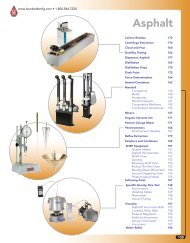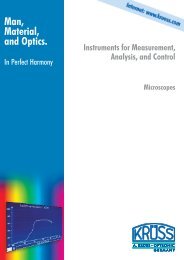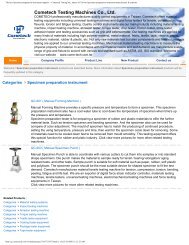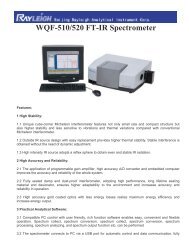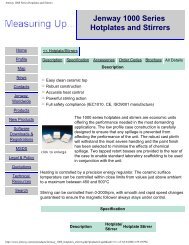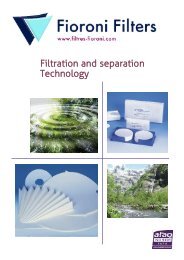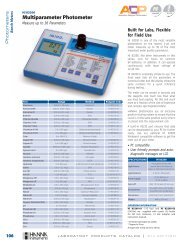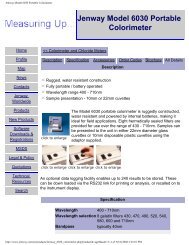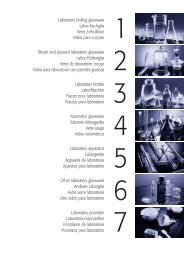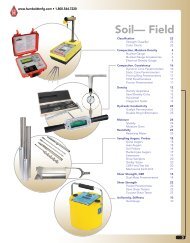Esco Labculture® Plus Class II Type A2 Biosafety Cabinet - Comlibris
Esco Labculture® Plus Class II Type A2 Biosafety Cabinet - Comlibris
Esco Labculture® Plus Class II Type A2 Biosafety Cabinet - Comlibris
You also want an ePaper? Increase the reach of your titles
YUMPU automatically turns print PDFs into web optimized ePapers that Google loves.
General Features Cont. / <strong>Class</strong> <strong>II</strong>I <strong>Cabinet</strong> Airflow Profile<br />
Intake Air<br />
Pre-filter<br />
Removes<br />
Larger<br />
Particles<br />
Exhaust Air is<br />
ULPA-filtered<br />
�<br />
�<br />
Positive Pressure Plenum<br />
Vertical Airflow<br />
�<br />
�Downflow / Supply ULPA Filter<br />
�First Exhaust ULPA Filter<br />
�Second Exhaust ULPA Filter<br />
•<br />
•<br />
•<br />
•<br />
•<br />
Air taken in from above the cabinet<br />
passes through a pre-filter and an ULPA<br />
filter. Moving into the main chamber of<br />
the cabinet in a vertical air stream, it<br />
provides product protection from airborne<br />
particulate matter and cross contamination.<br />
This vertical flow air stream is also known<br />
as the downflow.<br />
Close to the work surface, the downflow<br />
air stream “splits” with a portion entering<br />
grilles towards the front or back of the<br />
cabinet, providing a uniform downflow over<br />
the entire working area of the chamber.<br />
<strong>Esco</strong>’s unique airflow design ensures that air<br />
within the cabinet is replaced consistently,<br />
eliminating excessive air turbulence and the<br />
accumulation of particulate contamination<br />
in “dead air corners”.<br />
Air is moved within the cabinet below<br />
the work table, where is passes through<br />
two ULPA filters; one mounted below<br />
the work table, and the other above the<br />
main chamber. This provides a fail-safe<br />
mechanism in case any one of the ULPA<br />
filters fails to maintain containment.<br />
<strong>Esco</strong>’s unique blower system maintains<br />
negative pressure within the main work<br />
chamber under all circumstances. Unlike<br />
the competition, our <strong>Class</strong> <strong>II</strong>I biohazard<br />
safety cabinets do not utilize supply<br />
blowers, which, when improperly balanced,<br />
may result in the working area being<br />
positively pressurized.<br />
INDIVIDUAL PERFORMANCE TESTING<br />
Your safety means the world to us: the following tests are<br />
performed individually at our in-house laboratory on every cabinet<br />
produced:<br />
a. Airflow velocities<br />
b. <strong>Cabinet</strong> leak test<br />
c. Aerosol challenge test for filter integrity<br />
d. Light intensity / noise / vibration levels<br />
e. Airflow pattern visualisation test<br />
f. Electrical safety tests<br />
A detailed report is included with every cabinet detailing the tests<br />
performed and results obtained.<br />
Extensive testing is continuously performed at our research and<br />
development laboratories to improve cabinet containment and<br />
performance.<br />
Recommended re-certification is 12 months from initial date of<br />
operation; in addition, we recommend that where possible, onsite<br />
testing after delivery and installation should be conducted in<br />
accordance with the following standard: EN12469:2000 (Section<br />
6 Table 5).<br />
<strong>Esco</strong> Airstream® <strong>Class</strong> <strong>II</strong>I Biohazard Safety <strong>Cabinet</strong>: Airflow Profile<br />
•<br />
•<br />
All exhaust air is ULPA-filtered and<br />
exhausted directly back to the laboratory<br />
without re-circulation. Optionally, an<br />
exhaust collar can be fitted to allow air to<br />
be ducted via a dedicated ducting system<br />
to the external environment.<br />
Air velocity through an open glove port will<br />
be a minimum of 0.7m/s (140fpm) when a<br />
single port is open.<br />
<strong>Class</strong> <strong>II</strong>I Biohazard Safety <strong>Cabinet</strong>s are<br />
commonly specified for use with the<br />
world’s deadliest microbes. Drawing on the<br />
resources and expertise of our cleanroom<br />
engineering division, <strong>Esco</strong> is able to<br />
provide a complete turn-key service for<br />
the construction of critical environments to<br />
complement applications in which <strong>Class</strong> <strong>II</strong>I<br />
cabinets may be used.<br />
Although a <strong>Class</strong> <strong>II</strong>I safety cabinet provides<br />
an unparalleled degree of operator and<br />
environmental protection, safety can<br />
still be increased by the construction of<br />
negative pressure laboratories and the<br />
use of isolation suits. When a <strong>Class</strong> <strong>II</strong>I<br />
safety cabinet is operated within a negative<br />
pressure laboratory, any failure in the<br />
<strong>Class</strong> <strong>II</strong>I cabinet will still be isolated within<br />
the laboratory. Assuming the cabinet<br />
fails, contamination from the cabinet will<br />
“spill-over” into the laboratory but will not<br />
contaminate the general environment,<br />
since all air within the laboratory is filtered<br />
before being exhausted to the external<br />
environment.



